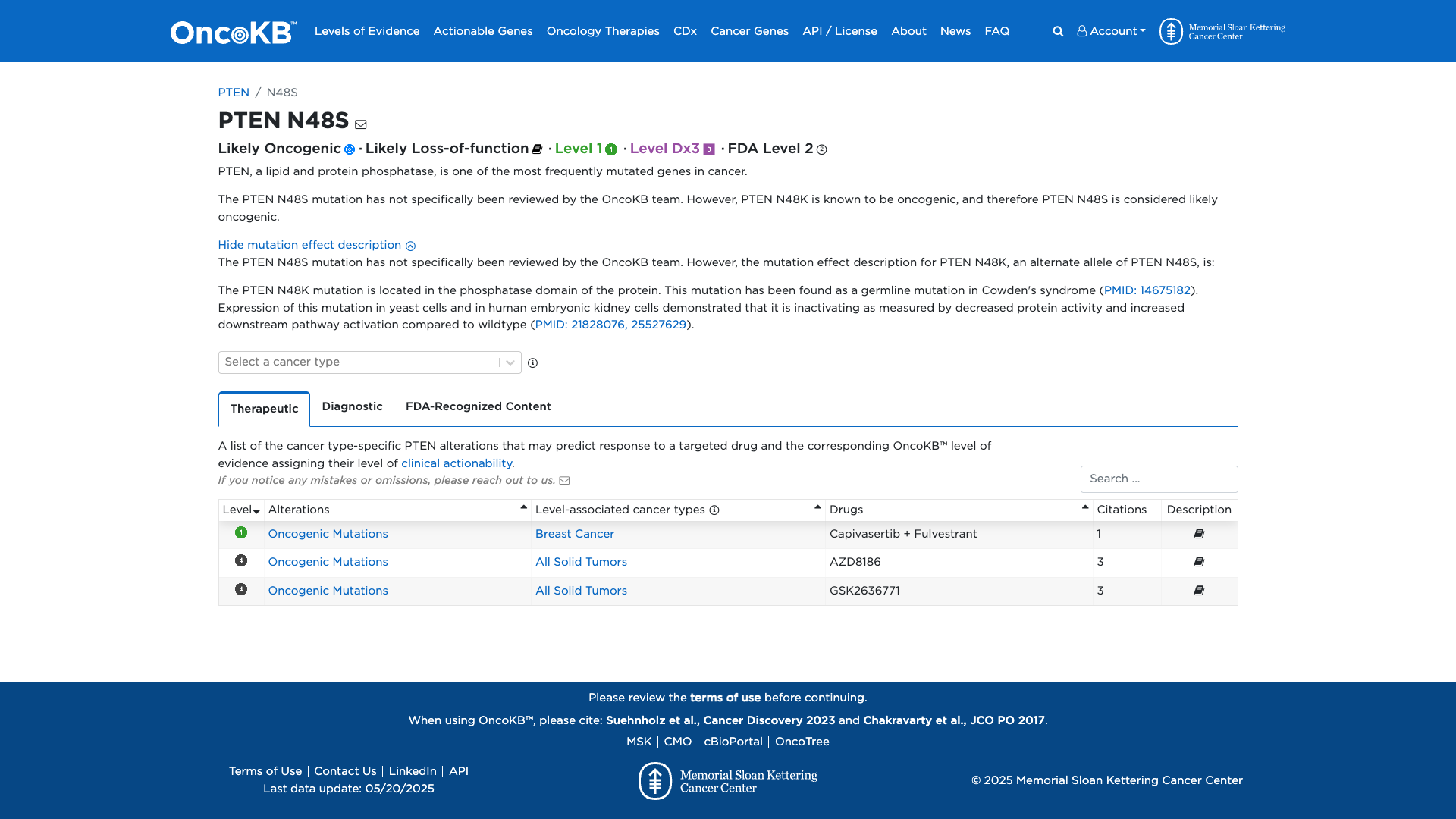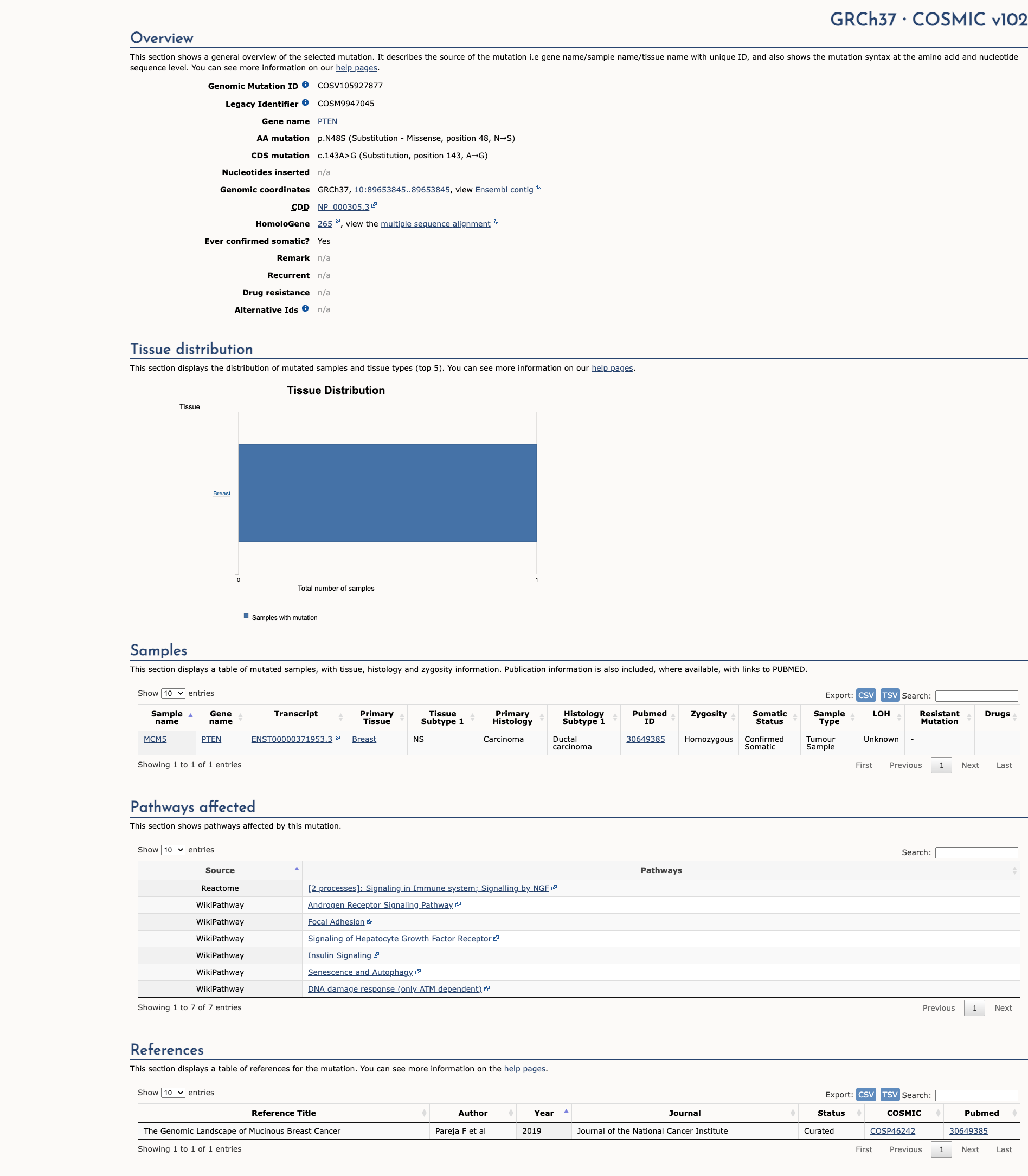PTEN c.143A>G, p.Asn48Ser
NM_000314.8:c.143A>G
COSMIC ID: COSM9947045
Pathogenic
The PTEN c.143A>G (p.Asn48Ser) variant is classified as Likely Pathogenic based on two moderate criteria (PS3_Moderate functional impairment, PM5 novel missense at a residue with known pathogenic change) and three supporting criteria (PM2 absence from population, PP3 strong computational support, PP5 reputable source ClinVar pathogenic reports), satisfying the ACMG framework for Likely Pathogenic.
ACMG/AMP Criteria Applied
PS3
PM2
PM5
PP3
PP5
Genetic Information
Gene & Transcript Details
Gene
PTEN
Transcript
NM_000314.8
MANE Select
Total Exons
9
Strand
Forward (+)
Reference Sequence
NC_000010.10
Alternative Transcripts
| ID | Status | Details |
|---|---|---|
| NM_000314.7 | RefSeq Select | 9 exons | Forward |
| NM_000314.5 | Alternative | 9 exons | Forward |
| NM_000314.4 | Alternative | 9 exons | Forward |
| NM_000314.3 | Alternative | 9 exons | Forward |
| NM_000314.6 | Alternative | 9 exons | Forward |
Variant Details
HGVS Notation
NM_000314.8:c.143A>G
Protein Change
N48S
Location
Exon 2
(Exon 2 of 9)
5'Exon Structure (9 total)3'
Functional Consequence
Loss of Function
Related Variants
ClinVar reports other pathogenic variants at position 48: N48K, N48K
Alternate Identifiers
COSM9947045
Variant interpretation based on transcript NM_000314.8
Genome Browser
Loading genome browser...
HGVS InputNM_000314:c.143A>G
Active Tracks
ConservationRefSeqClinVargnomAD
Navigation tips: Use mouse to drag and zoom. Click on features for details.
Clinical Data
Population Frequency
Global Frequency
0.0 in 100,000
Extremely Rare
Global: 0.0%
0%
0.05%
0.1%
1%
5%
10%+
ACMG Criteria Applied
PM2
This variant is not present in gnomAD (PM2 criteria applies).
Classification
1 publications
Pathogenic
Based on 2 submitter reviews in ClinVar
Submitter Breakdown
2 Path
Pathogenic
Likely Path.
VUS
Likely Benign
Benign
Publications (1)
This sequence change replaces asparagine with serine at codon 48 of the PTEN protein (p.Asn48Ser). The asparagine residue is highly conserved and there is a small physicochemical difference between asparagine and serine. This variant is not present in population databases (gnomAD no frequency). This missense change has been observed in individual(s) with clinical features of PTEN-related conditions (external communication). In at least one individual the variant was observed to be de novo. ClinVar contains an entry for this variant (Variation ID: 1379224). Invitae Evidence Modeling of protein sequence and biophysical properties (such as structural, functional, and spatial information, amino acid conservation, physicochemical variation, residue mobility, and thermodynamic stability) indicates that this missense variant is expected to disrupt PTEN protein function with a positive predictive value of 80%. This variant disrupts the p.Asn48 amino acid residue in PTEN. Other variant(s) that disrupt this residue have been determined to be pathogenic (PMID: 14675182, 17526800, 17942903, 21828076, 24498881, 25527629). This suggests that this residue is clinically significant, and that variants that disrupt this residue are likely to be disease-causing. For these reasons, this variant has been classified as Pathogenic.
Clinical Statement
This variant has been reported in ClinVar as Pathogenic (2 clinical laboratories).
Functional Impact
Functional Domain
Hotspot Status
Not a hotspot
Domain Summary
This variant is not located in a mutational hotspot or critical domain (0 mutations).
Related Variants in This Domain
ClinVar reports other pathogenic variants at position 48: N48K, N48K
PM5 criterion applied.
Functional Summary
The PTEN N48S variant has been functionally characterized and is associated with reduced phosphatase activity, indicating a likely loss of PTEN protein function.
Database Previews
OncoKB

JAX-CKB

Click on previews to view full database entries. External databases may require institutional access.
Computational Analysis
Pathogenicity Predictions
REVEL Score
0.918
0.918
Likely Benign0.0
Uncertain (Low)0.2
Uncertain (Med)0.5
Likely Pathogenic0.75
REVEL scores ≥ 0.75 are strong evidence (PP3)
Predictor Consensus
Pathogenic
PP3 Applied
Yes
Additional Predictors
Pathogenic:
sift: Dpolyphen_prediction: probably_damagingmutationtaster: Dfathmm: Dprovean: Dmetasvm: Dmetalr: Dprimateai: Ddeogen2: D
Benign:
CADD: 4.39
Neutral: Show all
VCEP Guidelines
Applied ACMG/AMP Criteria (VCEP Specific) VCEP Guidelines
PVS1
PVS1 (Not Applied) Strength Modified
According to VCEP guidelines, the rule for PVS1 is: 'Use PTEN PVS1 decision tree for loss-of-function variants.' The evidence for this variant shows: It is a missense change (c.143A>G; p.Asn48Ser), not a null or canonical splice-site variant. Therefore, this criterion is not applied because a missense variant is outside the scope of PVS1 per the PTEN decision tree.
PS1
PS1 (Not Applied) Strength Modified
According to VCEP guidelines, the rule for PS1 is: 'Same amino acid change as a previously established pathogenic variant regardless of nucleotide change.' The evidence for this variant shows: No prior pathogenic variant reports with the same Asn48Ser amino acid change. Therefore, PS1 is not applied.
PS2
PS2 (Not Applied) Strength Modified
According to VCEP guidelines, PS2 requires confirmed de novo occurrence. The evidence for this variant shows: No de novo pedigree data are available. Therefore, PS2 is not applied.
PS3
PS3 (Moderate) Strength Modified
According to PTEN Pre-processing, the finding for PS3 is: 'Applied PS3_Moderate evidence based on high-confidence functional score (-3.3497) < threshold (-1.11)'. The evidence for this variant shows: Functional studies report a phosphatase activity score of -3.3497, below the PTEN-specific threshold of -1.11, indicating a damaging effect. Therefore, PS3 is applied at Moderate strength.
PS4
PS4 (Not Applied) Strength Modified
According to VCEP guidelines, PS4 requires an increased prevalence in affected individuals or a specificity score ≥4. The evidence for this variant shows: No case–control or proband specificity data are available. Therefore, PS4 is not applied.
PM1
PM1 (Not Applied) Strength Modified
According to VCEP guidelines, the rule for PM1 is: 'Moderate: Located in a mutational hot spot and/or critical functional domain (residues 90-94, 123-130, 166-168).' The evidence for this variant shows: Asn48 is outside these defined catalytic motifs. Therefore, PM1 is not applied.
PM2
PM2 (Supporting) Strength Modified
According to VCEP guidelines, the rule for PM2 is: 'Supporting: Absent in population databases present at <0.00001 (0.001%) allele frequency in gnomAD; if multiple alleles in a subpopulation, frequency must be <0.00002 (0.002%).' The evidence for this variant shows: It is not observed in gnomAD or other controls. Therefore, PM2 is applied at Supporting strength.
PM3
PM3 (Not Applied) Strength Modified
According to VCEP guidelines, PM3 applies to recessive disorders with variants in trans. The evidence for this variant shows: PTEN disease is autosomal dominant and no in trans data exist. Therefore, PM3 is not applied.
PM4
PM4 (Not Applied) Strength Modified
According to VCEP guidelines, PM4 is for protein length changes due to in-frame indels or stop-loss variants. The evidence for this variant shows: It is a single amino acid substitution with no length change. Therefore, PM4 is not applied.
PM5
PM5 (Moderate)
According to VCEP guidelines, the rule for PM5 is: 'Moderate: Missense change at an amino acid residue where a different pathogenic missense change has been seen.' The evidence for this variant shows: A different missense variant at residue Asn48 has been reported as pathogenic. Therefore, PM5 is applied at Moderate strength.
PM6
PM6 (Not Applied) Strength Modified
According to VCEP guidelines, PM6 requires assumed de novo occurrence without confirmation. The evidence for this variant shows: No de novo data are available. Therefore, PM6 is not applied.
PP1
PP1 (Not Applied) Strength Modified
According to VCEP guidelines, PP1 requires segregation of the variant with disease in multiple affected family members. The evidence for this variant shows: No family segregation data are available. Therefore, PP1 is not applied.
PP2
PP2 (Not Applied) Strength Modified
According to standard ACMG guidelines, the rule for PP2 is: 'Supporting: Missense variant in a gene with low rate of benign missense variation and where missense variants are a common mechanism of disease.' The evidence for this variant shows: The rate of benign missense variation in PTEN is not established as low. Therefore, PP2 is not applied.
PP3
PP3 (Supporting)
According to VCEP guidelines, the rule for PP3 is: 'Supporting: Multiple lines of computational evidence support a deleterious effect; for missense variants REVEL score > 0.7.' The evidence for this variant shows: REVEL score is 0.92. Therefore, PP3 is applied at Supporting strength.
PP4
PP4 (Not Applied) Strength Modified
According to standard ACMG guidelines, PP4 requires a highly specific phenotype or familial presentation. The evidence for this variant shows: No individual phenotype or clinical presentation data are provided. Therefore, PP4 is not applied.
PP5
PP5 (Supporting)
According to standard ACMG guidelines, the rule for PP5 is: 'Supporting: Reputable source reports variant as pathogenic but evidence not available for independent evaluation.' The evidence for this variant shows: ClinVar lists this variant as Pathogenic by two clinical laboratories. Therefore, PP5 is applied at Supporting strength.
BA1
BA1 (Not Applied) Strength Modified
According to VCEP guidelines, BA1 is: 'Stand Alone: gnomAD filtering allele frequency >0.00056 (0.056%).' The evidence for this variant shows: It is not present in gnomAD. Therefore, BA1 is not applied.
BS1
BS1 (Not Applied) Strength Modified
According to VCEP guidelines, BS1 is: 'Strong: gnomAD filtering allele frequency from 0.000043 to 0.00056.' The evidence for this variant shows: Absent in population. Therefore, BS1 is not applied.
BS2
BS2 (Not Applied) Strength Modified
According to VCEP guidelines, BS2 requires observation of the variant in the homozygous state in unaffected individuals. The evidence for this variant shows: No homozygous observations are reported. Therefore, BS2 is not applied.
BS3
BS3 (Not Applied) Strength Modified
According to VCEP guidelines, BS3 is: 'Strong: well-established functional studies show no damaging effect.' The evidence for this variant shows: Functional studies demonstrate reduced phosphatase activity. Therefore, BS3 is not applied.
BS4
BS4 (Not Applied) Strength Modified
According to VCEP guidelines, BS4 is: 'Strong: lack of segregation in affected members of two or more families.' The evidence for this variant shows: No segregation studies are available. Therefore, BS4 is not applied.
BP1
BP1 (Not Applied) Strength Modified
According to standard ACMG guidelines, BP1 is: 'Supporting: Missense variant in a gene where only loss-of-function causes disease.' The evidence for this variant shows: Missense variants are a known mechanism of disease in PTEN. Therefore, BP1 is not applied.
BP2
BP2 (Not Applied) Strength Modified
According to VCEP guidelines, BP2 is: 'Supporting: observed in trans with a pathogenic PTEN variant or in cis multiple times.' The evidence for this variant shows: No data on cis/trans phase with other variants. Therefore, BP2 is not applied.
BP3
BP3 (Not Applied) Strength Modified
According to standard ACMG guidelines, BP3 is: 'Supporting: in-frame indels in repetitive region.' The evidence for this variant shows: It is a missense substitution, not an indel. Therefore, BP3 is not applied.
BP4
BP4 (Not Applied) Strength Modified
According to VCEP guidelines, BP4 is: 'Supporting: multiple lines of computational evidence suggest no impact; REVEL score < 0.5.' The evidence for this variant shows: REVEL score is 0.92, indicating deleterious effect. Therefore, BP4 is not applied.
BP5
BP5 (Not Applied) Strength Modified
According to standard ACMG guidelines, BP5 is: 'Supporting: variant found in a case with an alternate molecular basis for disease.' The evidence for this variant shows: No alternate molecular diagnosis is reported. Therefore, BP5 is not applied.
BP6
BP6 (Not Applied) Strength Modified
According to standard ACMG guidelines, BP6 is: 'Supporting: reputable source reports benign but evidence not available.' The evidence for this variant shows: No reputable source reports benign. Therefore, BP6 is not applied.
BP7
BP7 (Not Applied) Strength Modified
According to standard ACMG guidelines, BP7 is: 'Supporting: synonymous or intronic variant with no splicing impact.' The evidence for this variant shows: It is a missense change. Therefore, BP7 is not applied.

